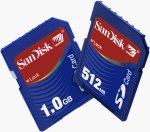| The following is an unedited press release, shown as received from the company represented. We've elected to present selected releases without editorial comment, as a way to provide our readers more information without further overtaxing our limited editorial resources. To avoid any possible confusion or conflict of interest, the Imaging Resource will always clearly distinguish between company-provided press releases and our own editorial views and content. |
 PRESS RELEASE: SanDisk introduces 1 Gigabyte and 512 Megabyte SD cards
PRESS RELEASE: SanDisk introduces 1 Gigabyte and 512 Megabyte SD cards
New Memory Cards Give Consumers Enough Capacity To Store Large Amounts Of Digital Images, Music And Video
HANNOVER, GERMANY, MARCH 13, 2003 - SanDisk Corporation (NASDAQ:SNDK) today introduced 1 gigabyte (GB) and 512 megabyte (MB) SD Cards, postage stamp-sized flash memory cards capable of storing large amounts of data, audio and video. The 1GB SD card quadruples the current capacity of SanDisk SD cards. With the 1GB SD card, consumers can store up to 30 hours of digitally compressed music, more than 320 minutes of MPEG-4 compressed video or more than 1000 high-resolution digital images. The new SanDisk SD cards were introduced at a press conference at the CeBIT trade show where SanDisk is demonstrating products in Hall 21, Booth B-24.
Wes Brewer, senior director of retail product marketing and business development at SanDisk, said, "The SD card has evolved as the storage medium of choice for many consumer electronics devices such as digital cameras, handheld computers, audio players and mobile phones. The popularity of the SD format in these new devices has created tremendous retail channel demand for higher capacity cards than those that accompany the device at the time of purchase. The introduction of our new high capacity SD cards makes it possible, for example, to store in excess of 400 high resolution digital images, literally hundreds of motion JPEG compressed video clips and up to 16 hours of MP3 music on a single card. We believe that our introduction of the 512MB and 1GB cards is perfectly aligned to meet both current and future demands of our end-use customers."
The SD card is a flash memory storage device with built-in Content Protection Rights Management designed to facilitate the secure exchange of content between devices and the card. To date, more than 200 products with slots for the card have been introduced. This number continues to increase as products such as digital cameras become smaller in size, taking advantage of the SD card's convenient form factor and large storage capacity.
The 512MB and 1GB SanDisk SD cards use one gigabit NAND flash memory chips, based on patented multi-level cell (MLC) technology pioneered by SanDisk. MLC allows two bits of data to be stored in one memory cell, doubling memory capacity.
SanDisk is currently shipping 16, 32, 64, 128, and 256MB SD cards. The 512MB and 1GB SanDisk SD cards have suggested retail prices of $169.99 and $329.99 respectively. The 512MB SD card is expected to be available in the second quarter while the 1GB SD card is expected to be available in the third quarter.
SanDisk, the world's largest supplier of flash data storage products, designs, manufactures and markets industry-standard, solid-state data, digital imaging and audio storage products using its patented, high density flash memory and controller technology. SanDisk is based in Sunnyvale, CA.
The matters discussed in this news release contain forward looking statements that are subject to certain risks and uncertainties as described under the caption, "Factors That May Affect Future Results" in the company's annual report on Form 10-K-A and quarterly reports on Form 10-Q, filed with the Securities and Exchange Commission. The companies assume no obligation to update the information in this release.
For more information or images on SanDisk and its products, contact www.sandisk.com
All trade names are either registered trademarks or trademarks of their respective holders.
(First posted on Thursday, March 13, 2003 at 17:33 EST)
|
Powered by Coranto
|